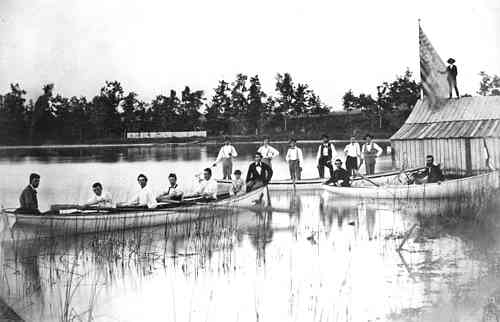
Notre Dame's Grotto / by Dorothy V. Corson

A'Hoy on the St. Joseph
An interesting article, "A'Hoy! on the St. Joe,"(216) described in detail the beautiful swift flowing St. Joseph River, as it was one hundred and twenty-two years ago. Notre Dame students and professors embarked from St. Angela's Island, on "the often contemplated trip" down the St. Joseph River to Niles, on July 4, 1873.

These our three good and fair galleys, [Notre Dame's early racing boats] the Santa Maria, the Pinta and the Nina darted from the northern point of St. Angela's Island at 10 a.m. They were manned by the merriest crew that ever beheld the swift St. Joseph. The boats were to keep 50 yards apart following one another; the little Nina, with Fathers Lemonnier, Carrier, Zahm and Berdel in the van; the Santa Maria following carrying seven aboard, Prof. Stace, coxswain, and the Pinta with seven more aboard, nobly bringing up the rear (which she never did before).
The account describes the river as it was in 1873:
Only a few rods from the point of embarkation, a huge boulder firmly driven in the swiftest part of the current suggested momentary fears of ill omen for the rest of the voyage. The Nina swung around it in approved style and in this was skillfully imitated by her two followers. The Dutch Gap, famous in Scholastic lore, was the next distressing peril. The St. Joseph took, once upon a time, into its head to change its bed, and regardless of the property of Mr. Von Dickenhausen, took a short cut across his field which it divided unequally into two parts, making him at the same time the sole undisputed proprietor of an Island. Well the new channel had been cursed by the evil-eyed Von Dickenhausen, so the legend says, and many a reckless adventurer had risked his life in its angry current. The old trees snatched from the stolen field blocked and obstructed the navigator's path, in a manner that made the boldest heart quiver with fear. The Nina, with the priests aboard, slackened speed and bade her followers to be on the watch and put on the brakes also. The peril, as it drew nearer, like fabled tales, grew less; and bolder grew the hearts of the shirking galleys. Little Nina with prow well directed and vigorous dash from the oar, nimbly jumped over the abyss and its whirlpool and in an instant more swam far beyond, just in good sight of her followers which followed her lucky track with the same dexterity and luck.
The river is described as they go along, the old Mill and its rosy looking and talkative miller (where Isaac Walton is now), "the cottages of Bertrand and its venerable old-fashioned bridge, the little church of the earlier St. Mary's Academy, a city once famous and thickly populated, now alas, reduced to a mere name." After several landings to view the beautiful groves on the shore of the river, the Niles dam is sighted and portaged and Niles is reached:
The best speed was now made, all the oars were lustily plied -- the wooded bridge was cleared in a twinkling, then the iron bridge. At last the landing was reached, and the travelers got for the last time on terra firma. Half an hour later the boats were placed on board a car of the M. C., and at 5 1/2 P.M. all were back at Notre Dame.
Two years later, the October 1875 Scholastic, reported the fate of the noble Pinta. "The Pinta now sleeps the sleep of peace on the bottom of the lake. She preferred death to defeat -- and she got it."(217) She must have had lots of company there among the many other items discarded in the lake.
One can only wonder what caused this quiet sanctuary to become, once again, an untamed wilderness.